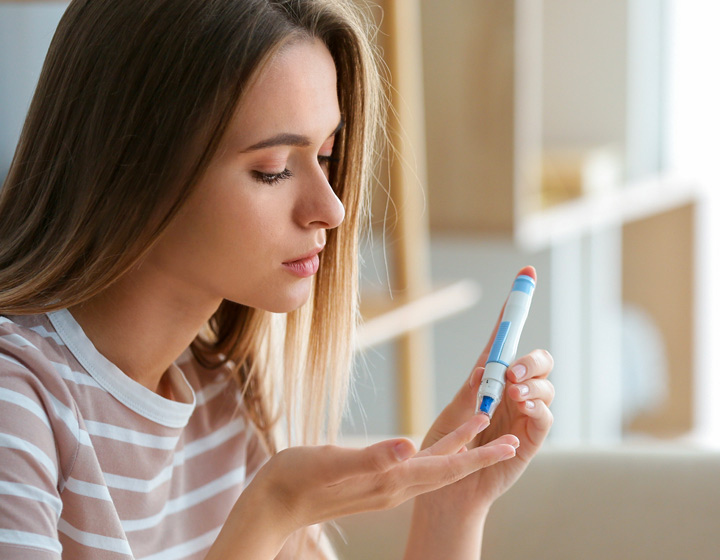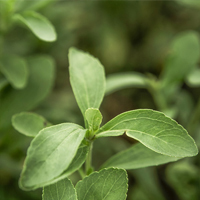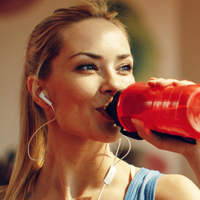
甜菊糖与糖尿病管理
糖尿病是一种慢性疾病。当胰腺无法产生足够的胰岛素,或者身体无法有效利用胰腺所产生的胰岛素时,就会引发糖尿病。这会导致血液中的葡萄糖浓度增加,俗称高血糖症,可导致神经和血管损伤,并增加心脏病发作、中风和肾衰竭的风险。
糖尿病发病数在全球范围内呈上升趋势。全球范围内的评估结果表明,2021 年每 10 个成年人当中就有 1 人患有糖尿病(5.37 亿),比 2017 年多出 1 亿多人。如果您是糖尿病患者或已被诊断为患有前驱糖尿病,您应当了解良好的营养也是维持身体健康的最重要因素之一。您的饮食习惯、体育锻炼、保持正常体重并在医生建议的情况下服用药物,这会对您的日常健康产生很大的影响。

通过饮食和锻炼管理血糖水平
虽然人们无法改变糖尿病的部分致病因素,如遗传、年龄增长和家族病史,但保持健康的体重和定期进行体育锻炼对控制血糖水平有着至关重要的作用。
幸运的是糖尿病患者并不需要戒掉所有喜爱的食物。您可以真正做到两者兼得,当然只是偶尔,您只需将甜菊糖纳入您的饮食计划中。
这就是甜菊糖的神奇之处。甜菊糖甜味剂产品不含碳水化合物,因此不会单独影响血糖或胰岛素水平。当您纵享甜香的美食时,甜菊糖甜味剂可降低许多食物和饮料中的糖分和卡路里。
有研究明确表明,甜菊糖苷对糖尿病患者的血糖稳态不会产生影响。122 名成年人参与了一项为期 16 周的随机对照试验。他们在一天内服用四次约 330 毫克的甜菊醇当量(约 4-6 包餐桌健康型甜菊糖),与安慰剂组相比,对血糖水平没有影响。这项研究使用了莱苞迪甙 A (>97% )。
此外,美国营养与饮食学会发表的关于营养性和非营养性甜味剂的立场文件回顾了五项随机对照试验,研究了甜菊糖相较于安慰剂对代谢结果的影响。关于这些研究汇总的成果报告指出,甜菊糖对血糖、胰岛素水平、高血压和体重的影响很小,甚至没有任何影响。
目前已证实健康受试者和糖尿病患者在食用低糖和低卡路里膳食后,甜菊糖可以显著降低餐后血糖水平。在一项研究中,患有 2 型糖尿病的受试者报告指出,与食用“安慰剂”测试餐后的情况相比,食用“甜菊糖”测试餐后的餐后血糖和胰高血糖素反应有所降低。
将甜菊糖和阿斯巴甜与蔗糖对 31 名肥胖和瘦弱受试者的餐后血糖和胰岛素水平的影响进行比较后发现,在完成甜菊糖餐前负荷后的 20 分钟以及吃完午餐后的 30 分钟,血糖水平明显降低。此外,与蔗糖相比,摄入甜菊糖后的餐后胰岛素水平也显著降低(p=0.03)。
现在,从沙拉酱到饮料和快餐店,全世界琳琅满目的产品中都出现了甜菊糖的身影,摄入甜菊糖可以让糖尿病患者在控制热量摄入的同时,享受香甜的美味。甜菊糖通常与食糖等营养型甜味剂搭配食用,或搭配含有其他简单碳水化合物的食品和饮料食用,因此,检查成分标签中的总碳水化合物含量和整体营养信息仍然至关重要。
您会在各种食品和饮料中发现甜菊糖的身影,其中包括茶、软饮料、果汁、酸奶、豆浆、烘焙食品、麦片、沙拉酱和甜点等,同时,您会发现甜菊糖可用作餐桌健康型甜味剂。甜菊糖也是糖尿病患者专用食谱的理想选择。在烘焙和烹饪过程中,甜菊糖会释放出淡淡的甜味,基本符合食谱对营养和糖分的要求。
参考文献
- International Diabetes Federation Atlas 10th edition Available at: https://diabetesatlas.org/#:~:text=Diabetes%20around%20the%20world%20in%202021%3A,and%20783%20million%20by%202045.
- World Health Organization. Global Report on Diabetes. Available at: http://www.who.int/diabetes/global-report/en/
- International Diabetes Federation. IDF Clinical Practice Recommendations for Managing Type 2 Diabetes in Primary Care. Available at: https://www.idf.org/e-library/guidelines/128-idf-clinical-practice-recommendations-for-managing-type-2-diabetes-in-primary-care.html.
- Fitch C and Keim KS. Position of the Academy of Nutrition and Dietetics: Use of nutritive and nonnutritive sweeteners. J Acad Nutr Diet. 2012;112:739–58. Available at: https://jandonline.org/article/S2212-2672(12)00325-5/fulltext
- Gardner C, et. al. Nonnutritive sweeteners: Current use and health perspectives: A scientific statement from the American Heart Association and the American Diabetes Association. Circulation. 2012;126:509–19. Available at: http://circ.ahajournals.org/content/126/4/509.long
- Anton SD, et. al. Effects of stevia, aspartame, and sucrose on food intake, satiety, and postprandial glucose and insulin levels. Appetite. 2010;55:37–43. Available at: https://www.ncbi.nlm.nih.gov/pmc/articles/PMC2900484/
- Jeppesen PB. Is there a correlation between high sugar consumption and the increase in health problems in Latin America. Chapter 1. Sugar and Modernity in Latin America: Interdisciplinary Perspectives. Mariano de Carvalho V, Hojlund S, Jeppesen PB, Simonsen K-M (eds.) Aarhus: Aarhus University Press; 2014. pp. 25-54.
- American Diabetes Association® Standards of Medical Care in Diabetes 2017. Diabetes Care Jan 2017, 40 (Supplement 1). Available online: http://care.diabetesjournals.org/content/40/Supplement_1
- EFSA Panel on Dietetic Products, Nutrition, and Allergies (NDA); Scientific Opinion on the substantiation of health claims related to intense sweeteners and contribution to the maintenance or achievement of a normal body weight (ID 1136, 1444, 4299), reduction of post-prandial glycaemic responses (ID 4298), maintenance of normal blood glucose concentrations (ID 1221, 4298), and maintenance of tooth mineralisation by decreasing tooth demineralisation (ID 1134, 1167, 1283) pursuant to Article 13(1) of Regulation (EC) No 1924/2006. EFSA Journal 2011;9(6):2229. [26 pp.]. doi:10.2903/j.efsa.2011.2229. Available online: www.efsa.europa.eu/efsajournal
- Maki et al., Chronic consumption of rebaudioside A, a steviol glycoside, in men and women with type 2 diabetes mellitus, Food and Chemical Toxicology. 2008;46:S47-S53
- Academy of Nutrition and Dietetics. Position of the Academy of Nutrition and Dietetics: use of nutritive and nonnutritive sweeteners. 2012; 112 (5): 739-758.
- Gregersen S, et al., Antihyperglycemic effects of stevioside in type 2 diabetic subjects. Metabolism. 2004; 53(1): 73-76.
- Anton SD, Martin CK, Han H, Coulon S, Cefalu WT, Geiselman P, Williamson DA. Effects of stevia, aspartame, and sucrose on food intake, satiety, and postprandial glucose and insulin levels. Appetite. 2010 Aug;55(1):37-43.




